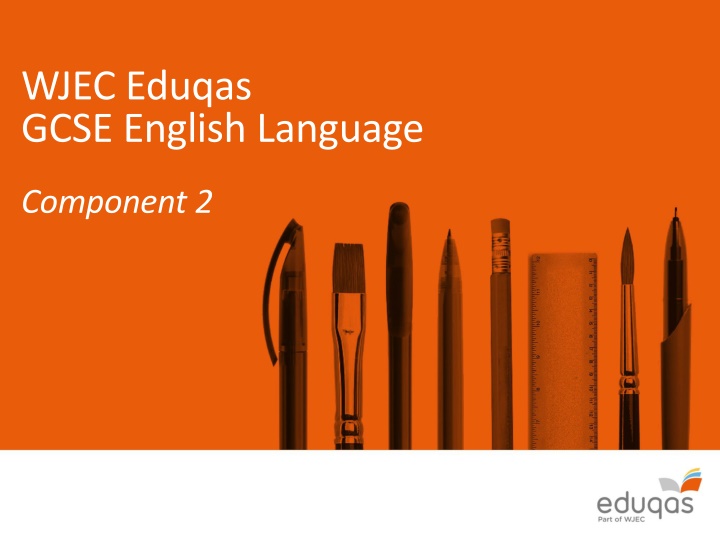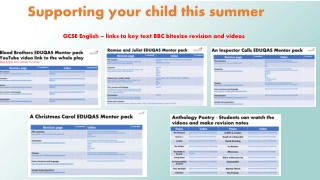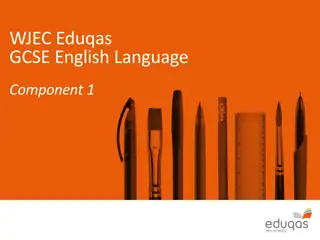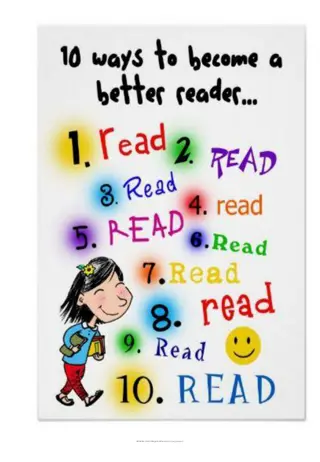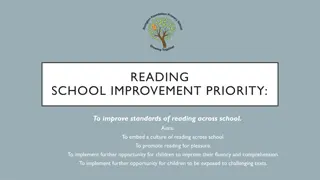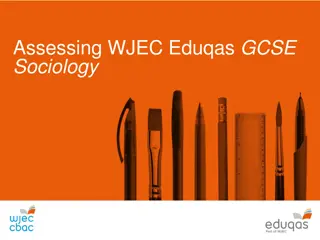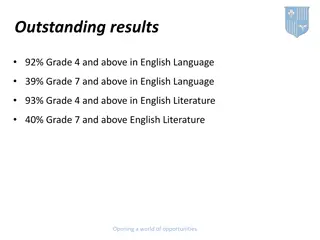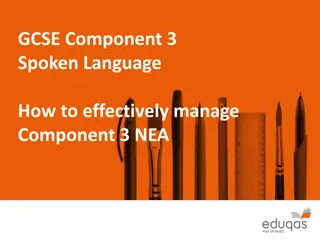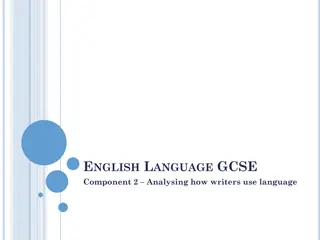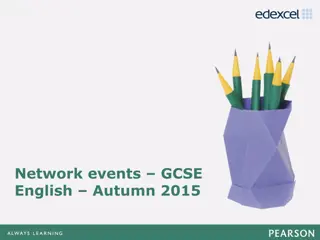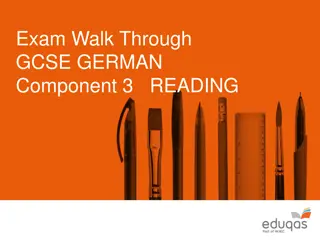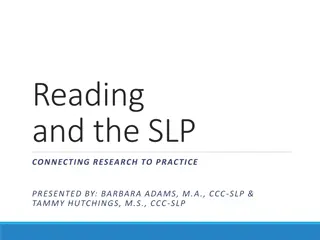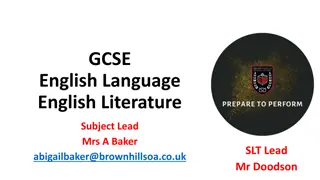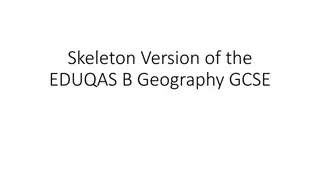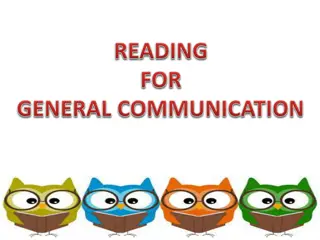Enhancing Reading Skills in WJEC Eduqas GCSE English Language Component 2
This comprehensive guide focuses on improving reading skills in WJEC Eduqas GCSE English Language Component 2. It covers assessment objectives, key messages from the Principal Examiner, and strategies for interpreting information, analyzing text, and evaluating responses. It also provides tips on approaching reading questions effectively and using relevant terminology to support analytical views. The resource aims to enhance students' understanding and performance in reading assessments.
Download Presentation

Please find below an Image/Link to download the presentation.
The content on the website is provided AS IS for your information and personal use only. It may not be sold, licensed, or shared on other websites without obtaining consent from the author.If you encounter any issues during the download, it is possible that the publisher has removed the file from their server.
You are allowed to download the files provided on this website for personal or commercial use, subject to the condition that they are used lawfully. All files are the property of their respective owners.
The content on the website is provided AS IS for your information and personal use only. It may not be sold, licensed, or shared on other websites without obtaining consent from the author.
E N D
Presentation Transcript
WJEC Eduqas GCSE English Language Component 2
Component 2-Aims of Session Brief reminder of Reading and Writing assessment objectives To consider the Principal Examiner s key messages and lessons learnt (June 2019 series) To focus on Reading skills of analysis (AO2) and evaluation (AO4) To review a number of candidate responses focusing on Q02, Q04 and Q22 (the prom letter) with marking exercises To consider possible approaches to teaching transactional writing and resources available
COMPONENT 2 ASSESSMENT OBJECTIVES READING Identify and interpret explicit and implicit information and ideas (assessed in Question 11 and 13) Select and synthesise evidence from different texts (assessed in Question 15) AO1 Explain, comment on and analyse how writers use language and structure to achieve effects and influence readers, using relevant subject terminology to support their views (assessed in Question 12 ) AO2 Compare writers' ideas and perspectives, as well as how these are conveyed, across two or more texts (assessed in Question 16) AO3 Evaluate texts critically and support this with appropriate textual references (assessed in Question 14) AO4 Each Reading question targets ONE assessment objective.
Component 2 Reading: Principal Examiner s Key Messages Read the instructions at the start of each question carefully to avoid answering on the wrong text Don t lose marks in Q11 and Q13 by not reading the question properly Remember the mark tariff per question and plan time accordingly e.g. synthesis question is worth 4 marks and should be dealt with fairly quickly Keep the focus of the question firmly in mind e.g. the focus for Q16 was the day of the rescue Support points with appropriate evidence
Component 2 Reading: Principal Examiner s Key Messages Use relevant terminology where AO2 is assessed. Avoid feature spotting or making terminology the starting point for a comment Select relevant evidence and detail and, where appropriate, comment on/explore the impact of the detail Avoid quoting facts/statistics unless they are worthy of greater exploration The synthesis question is best tackled by dealing with the details from each specific text before considering any details that appear in both texts Use the bullet points in Q16 to structure a response and make it clear which text is being referred to.
Question 12 AO2 how writers use language and structure to achieve effects and influence readers, using relevant subject terminology to support their views. Explain, comment on and analyse
Component 2 Assessment in Practice Question 12 Indicates that AO2 is being assessed and that language and structure should be commented on and analysed Focus of the question How does Jeffrey Brown try to show how hard it was for the trapped miners during their long ordeal underground ? You should comment on: what he says how he says it Other ways he tries to show how hard it was for the trapped miners Same message as Component 1-consider what is said as well as how it is said. [10] You must refer to the text to support your comments.
Characteristics of a successful response Clear focus on the hardships Methodical tracking of the text There are a range of relevant points Points are supported with appropriate evidence from the text The impact of the details are explored effectively Analysis of the writer s techniques and use of language is focused and coherent Use of subject terminology is relevant and is embedded in the response
Characteristics of a less successful response Points made do not always focus on the question There is limited tracking of the text Devices are spotted with little explanation of effect Little attempt to analyse language or probe the details of the text Range is limited for a 10 mark question There is an awareness of what but not how
Question 14 AO4 Evaluate texts critically and support this with appropriate textual references.
Component 2 Assessment in Practice Question 1.4 In the first three paragraphs of the account, the writer gives the impression that the accident was so serious that the trapped miners would not be found alive. Focus of question How far do you agree with this statement? You should comment on: Indicates AO4 is being assessed what he says how he says it You must refer to the text to support your answer. [10] Opinions should be supported with aptly selected textual evidence. What does the writer say that makes you think/feel a certain way?
Activity Exemplar 1 Read this candidate s response and, using the marking scheme provided, decide which Band is most appropriate. What could be done to improve this response? Thousands were seen rushing to the spot. This implies that the whole cave had collapsed and everyone rushed up there to see what happened but also implies that the miners were dead so people wanted to pay their respects. It agreed that the only hope. This implies that they only had one thing to do and if they don t do it then they could die or have already died. Whether the collapse had buried them alive. There is little hope that the miners are alive.
Activity: Exemplar 1 Needs a clearer sense of whether they agree/partly agree with the statement or not Needs to range across the text more Does select some basic textual evidence but with limited explanation as to how the selected text supports opinions. Not always useful to start with a quote and the use of quotations could be more secure Needs to track the details more carefully
Characteristics of a successful response Focuses on the statement given in the question and all points linked to it Supports opinions with textual evidence Clear point of view and clarity of thought Evaluation of authorial methods and how these methods have shaped opinions (aware of the text as a piece of non-fiction) Clear evaluation based on a good range of evidence tracks the details in order to sustain or develop their viewpoint. (Component 2 Principal Examiner s Report June 2019)
Characteristics of a less successful response No clear focus on statement given in question Opinions are not supported with appropriate textual evidence Lack of range of points (limited to one paragraph or part of the text) Opinions lack clarity of thought Limited comment on how the writer has helped shape opinions Assertions rather than supported opinions
Component 2 Example Question Stems AO1: Identify and interpret explicit and implicit information and ideas Give one example List How many Give two details AO1: Select and synthesise evidence from different texts According to both writers Using information from both texts
Component 2 Example Question Stems AO2: Explain, comment on and analyse how writers use language and structure to achieve effects and influence readers, using relevant subject terminology to support their views How does the writer of the article/letter/report etc show ? How does the writer present ? How does the writer try to show AO3: Compare writers' ideas and perspectives, as well as how these are conveyed, across two or more texts Compare: What the writers say about How the writers get across The writers attitudes towards/views on
Component 2 Example Question Stems AO4: Evaluate texts critically and support this with appropriate textual references Statement/Viewpoint/Quote followed by: How far do you agree with this view? To what extent do you agree with this view? How successfully/effectively does the writer ? What do you think and feel about ?
Section B: Transactional Writing
COMPONENT 2 ASSESSMENT OBJECTIVES - WRITING WRITING (50% of the overall qualification) AO5 Communicate clearly, effectively, and imaginatively, selecting and adapting tone, style and register for different forms, purposes and audiences; Organise information and ideas, using structural and grammatical features to support coherence and cohesion of texts. AO6 Candidates must use a range of vocabulary and sentence structures for clarity, purpose and effect, with accurate spelling and punctuation. (This requirement must constitute 20% of the marks for the specification as a whole.)
Principal Examiners Key Messages Split time equally between the two tasks Write at sufficient length to develop ideas, opinions and information effectively Address the audience and purpose given in the task Adopt an appropriate tone for the task Format letters appropriately and include a suitable greeting and sign off Spend time checking basic punctuation and grammar Take time to plan and structure responses Sequencing of ideas is important in developing an argument/point of view Depth and detail will help to develop convincing responses
Transactional Writing This is not a definitive list but pupils should practise writing the following in preparation for Component 2, Section B: Article e.g. Newspaper or Magazine Informal Letter Formal Letter Report Speech/talk Guide (on a specified topic) e.g. a guide for GCSE students on how to manage exams Review Please note that leaflets are no longer a valid transactional task as this type of writing would make it potentially difficult for candidates to achieve the criteria in the highest bands.
Component 2 Assessment in Practice Question 22 Your headteacher has decided that there should not be an end of year celebration such as a school prom or party. The headteacher believes it would just be an excuse for students to show off in an expensive way. Write a letter to your headteacher giving your opinion on this. [20]
Comparative Judgement Read exemplars 1 and 2. Which exemplar is better and why? Using the marking scheme and additional task specific guidance in your Excerpts from Marking Guidelines 'booklet, highlight which AO5 and AO6 skills are being demonstrated in these responses Teaching tip: Ask pupils to do a similar activity highlighting the key skills they can identify.
Component 2 Assessment in Practice Sequencing and shaping ideas excerpt from Principal Examiner s Report The second task required some shaping of arguments and how to present the arguments in the most convincing way.
Component 2 Assessment in Practice Sequencing and shaping ideas Activity: Read the three plans in response to the prom letter in the back of your Component 2 booklet. Which example is likely to be most successful and why? Which example is likely to be least successful and why? Discussion: How could this sort of task be used with pupils to help them think about sequencing and developing details? What other approaches to teaching these skills have worked well in the classroom?
Characteristics of a successful response Clear understanding of the audience (the headteacher in this instance) and formality needed The right tone is adopted for the purpose and audience Clear understanding of purpose (to give and support opinions) Maintains point of view throughout A range of specific details relating clearly to the task set to develop a clear line of argument Sustained piece to develop key points in enough detail Overall control of spelling, punctuation and grammar Logical sequence of paragraphs/ideas Accurate use of vocabulary suited to the audience
Characteristics of a less successful response Not addressing the specified audience Insecure understanding of purpose Limited range of specific details Brief response that doesn t develop a coherent argument Basic technical errors throughout the response Lack of paragraphs/topic sentences to organise the response Vocabulary used isn t suited to task/audience
Possible approaches to teaching transactional writing Task: Write a letter to your headteacher giving your views on a proposal to introduce a strict healthy eating menu and exercise regime at school. Starter: Hand out the sentence stem cards- one per pair. Divide the class into FOR or AGAINST the proposal. Pupils to plan an argument using the sentence stems as an opening. E.g. It is difficult to understand but not all pupils enjoy exercise Teacher to hear the class findings as a debate and record the ideas on the board for the next task.
Use the sentence starters to help you organise and formulate your arguments.
Next steps Task: In pairs work on the for and against ideas. Using the letter format, pupils are to compose a response using the sentence stems as a framework. One pupil focuses on for and the other on against. They can then help each other with the counter-arguments. Whole class feedback and discussion.
Use the letter format to organise your ideas. The sentence stems are a guide to introduce your points. Use examples and anecdotes to expand on these arguments Once completed- read aloud to your partner to hear the opposing view.
Useful Websites British Library https://www.bl.uk/ The British newspaper archive Englicious http://englicious.org/ Grammar and punctuation exercises Tes secondary English resources
